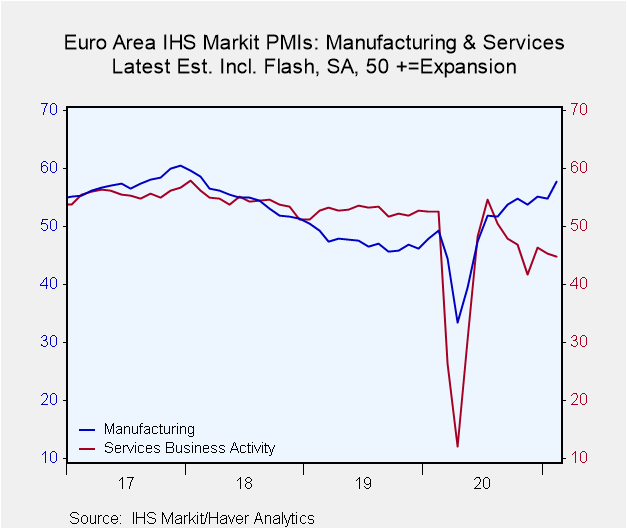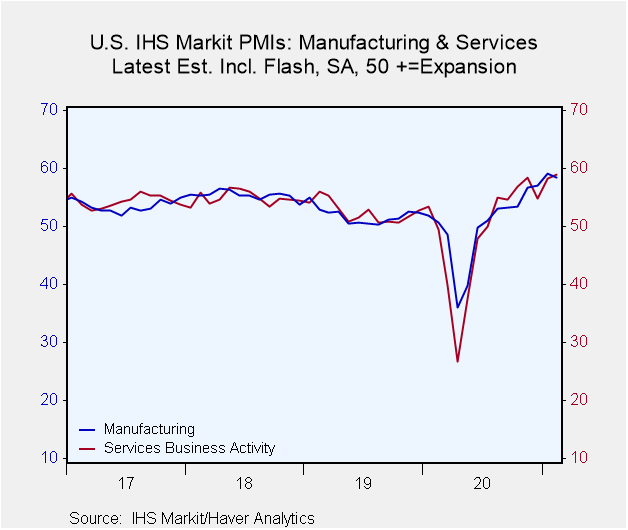 Global| Feb 19 2021
Global| Feb 19 2021Flash PMIs Largely Improve But Contractions Linger
Summary
PMI values largely improved in February. Yet, for many countries as well as for the EMU, economic contraction remains in place. Germany and the United States are exceptions with each showing PMI values above 50; the U.S. is showing [...]
 PMI values largely improved in February. Yet, for many countries as well as for the EMU, economic contraction remains in place. Germany and the United States are exceptions with each showing PMI values above 50; the U.S. is showing very strong readings.
PMI values largely improved in February. Yet, for many countries as well as for the EMU, economic contraction remains in place. Germany and the United States are exceptions with each showing PMI values above 50; the U.S. is showing very strong readings.
The services sector is contracting everywhere except in the U.S. where it is also brandishing a strong reading. Also the services sector weakened this month in every entry on the table except the U.K. where services improved sharply after being held back by an extreme lockdown and in the U.S. where they advanced along with manufacturing and show the strongest and most unusual readings in the table. Manufacturing improved everywhere in February and no entry in the table shows a manufacturing PMI below 50. Manufacturing is expanding everywhere without exception. But that is barely true in Japan, a country that just turned the corner on growth in the sector.
Expanding and being strong are two different things. Of the 12 pairs of readings (looking and manufacturing and services and setting aside the composite), there are twelve sector observations. Five of them have below median queue standings. Those five are for the services sector in Japan, the U.K., France, Germany, and the EMU region. And because of the heavy weight of services in the composite index, the composite is below its median in each of these countries as well as in the EMU. The U.S. has exceptional high 90s queue standing readings for manufacturing, services and for the composite.
Manufacturing generally is gaining momentum progressively as its average is stronger over 12 months than it was 12 months ago everywhere but France and Japan. The average is stronger over six months than it was over 12 months without exception. And the average is stronger over three months than over six months except in France. On the other hand, services have been much more erratic. First the sector average is generally weaker over the last 12 months than it was over the previous 12 months (the U.S. is the only exception to that) and the average is very much stronger over six months than it was over 12 months without exception. But for most countries and for the EMU, the service sector average is weaker over three months than over six months- the U.S. and Japan are both exceptions.
 These trends are apparent on the graphic. There we see manufacturing on an ongoing uptrend as the services sector continues to weaken progressively. The gap between the manufacturing and services PMIs has been widening everywhere except in the United States and Japan. The PMI gap for all units excluding the U.S. is 5.7 diffusion points for the 12-month average, down to 5.3 points over six months then up to 7.9 points over three months. The last three-months show the gap widening from 6.5 in December to 8.5 in January to 9.8 in February. Contrarily, the U.S. gap has been shrinking and as of February the gap is negative with the services PMI stronger than the manufacturing PMI.
These trends are apparent on the graphic. There we see manufacturing on an ongoing uptrend as the services sector continues to weaken progressively. The gap between the manufacturing and services PMIs has been widening everywhere except in the United States and Japan. The PMI gap for all units excluding the U.S. is 5.7 diffusion points for the 12-month average, down to 5.3 points over six months then up to 7.9 points over three months. The last three-months show the gap widening from 6.5 in December to 8.5 in January to 9.8 in February. Contrarily, the U.S. gap has been shrinking and as of February the gap is negative with the services PMI stronger than the manufacturing PMI.
These are extremely unusual dynamics. Having services and manufacturing go their own separate ways –opposite directions- for such an extended period of time speaks of a massive disconnect in the economy. Usually when a gap emerges, we begin to wonder whether the weak sector will pull the strong one down or vice versa. But in this situation, the virus has built a sort of wall between the two sectors. Manufacturing has continued to improve while the virus has nipped at the heels of the services sector keeping large parts of it shuttered. The manufacturing revival has been prevented from getting to the services sector.
The graphic clearly shows that in EMU the virus struck and then manufacturing recovered and built its progress steadily. For services the virus struck, the sector rebounded, but could not sustain itself and has had ongoing erosion. The U.S. situation has been different and it has been fed by rounds of government stimulus and special programs. This intervention has succeeded in putting both sectors into ongoing improvement and recovery. Still, it has been an expensive process and there are still some who have fallen through the cracks. The U.S. and Europe now are having very different recoveries despite being buffeted by very similar forces.
Caveat: I have taken these data at face value to analyze them. However, with so many service sector firms shuttered and out of business in the U.S., this diffusion index is subject to how the collection agency treats non-respondents. It is somewhat suspicious that the U.S. shows such incredible strength in the services sector with some 10 million people (mostly service sector workers) still unemployed and with countless businesses- many of them small businesses- closed. I am somewhat suspicious of the very high readings in the services sector. Although remember that these are only breadth statistics and even if the sector is smaller if the breadth is better the diffusion index will be higher.
Robert Brusca
AuthorMore in Author Profile »Robert A. Brusca is Chief Economist of Fact and Opinion Economics, a consulting firm he founded in Manhattan. He has been an economist on Wall Street for over 25 years. He has visited central banking and large institutional clients in over 30 countries in his career as an economist. Mr. Brusca was a Divisional Research Chief at the Federal Reserve Bank of NY (Chief of the International Financial markets Division), a Fed Watcher at Irving Trust and Chief Economist at Nikko Securities International. He is widely quoted and appears in various media. Mr. Brusca holds an MA and Ph.D. in economics from Michigan State University and a BA in Economics from the University of Michigan. His research pursues his strong interests in non aligned policy economics as well as international economics. FAO Economics’ research targets investors to assist them in making better investment decisions in stocks, bonds and in a variety of international assets. The company does not manage money and has no conflicts in giving economic advice.






